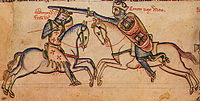- Battle of Assandun
-
Battle of Assandun 
Edmund Ironside (left) fights Canute the Great (right).Date 1016 Location Ashdon or Ashingdon Result Decisive Danish victory Belligerents 
Danes
EnglandCommanders and leaders Canute the Great
Thorkell the High
Eiríkr HákonarsonEdmund Ironside
Eadric StreonaThe Battle of Assandun was fought on 18 October 1016. There is dispute over whether Assandun may actually be today's Ashdon, or the long supposed Ashingdon, in southeast Essex, England.
It was a victory for the Danes, led by Canute the Great, who triumphed over the English army led by King Edmund II ('Ironside'). The battle was the conclusion to the Danish reconquest of England.
Canute had besieged London with major support from the English nobility against the Saxon hierarchy; particularly the Southampton nobles. The siege was in response to Edmund's reconquest of recently Danish-occupied Wessex, as well as conducting various indecisive offensives against Canute's army. London had withstood the siege and Edmund repulsed the Danes, but needed troops following a successful attack against the Danes in Mercia.
Leaving London, Edmund risked travelling into the countryside, dominated by enemies and at risk of being attacked by Danish soldiers. Canute's intelligence became aware of Edmund's movements, and while marching through Essex, Edmund's army was intercepted by Canute. The surprise interception overwhelmed the English, causing some of them to desert, and the Danes poured on the English, killing much of the nobility. Some sources claim that the Danes were losing ground, and that Eadric Streona had previously made a deal with Canute to desert the other English forces.
Following his defeat King Edmund II was forced to sign a treaty with Canute in which all of England except for Wessex would be controlled by Canute, and when one of the kings should die, the other king would take all of England; his sons being the heir to the throne. After Edmund's death on 30 November, Canute ruled the whole kingdom.
A few years later saw the construction of St. Andrews memorial church in 1020 on the hill of the presumed site of the Battle in Ashingdon, which still stands to this day. The church was founded after Canute's succession to the throne in 1020.
Primary sources
The Anglo-Saxon Chronicle has a brief account of the battle.
“ When the king learned that the enemy army had gone inland, for the fifth time he collected all the English nation, and pursued them and overtook them in Essex at the hill which is called Ashingdon, and they stoutly joined battle there. Then Ealdorman Eadric did as he had often done before, he was the first to start the fight with the Magonsæte [i.e. of Herefordshire], and thus betrayed his liege lord and all the people of England. There Cnut had the victory and won for himself all the English people. There was Bishop Eadnoth killed, and Abbot Wulfsige, and Ealdorman Ælfric, and Godwine, the ealdorman of Lindsey, and Ulfcetel of East Anglia, and Æthelweard, son of Ealdorman Æthelwine, and all the nobility of England was there destroyed.[1] ” The battle is also mentioned briefly in Knýtlinga saga which quotes a verse of skaldic poetry by Óttarr svarti, one of Canute's court poets.
“ King Knut fought the third battle, a major one, against the sons of Æthelred at a place called Ashington, north of the Danes' Woods. In the words of Ottar: - At Ashington, you worked well
- in the shield-war, warrior-king;
- brown was the, flesh of bodies
- served to the blood-bird:
- in the slaughter, you won,
- sire, with your sword
- enough of a name there,
- north of the Danes' Woods.[2]
” The most detailed account of the battle is in Encomium Emmae.
References
- ^ "ANGLO-SAXON CHRONICLE C, s.a. 1016". Heinrich-Heine-University Duesseldorf. Archived from the original on 2007-09-29. http://web.archive.org/web/20070929130826/http://www.phil-fak.uni-duesseldorf.de/anglist1/html/chronicle.html. Retrieved 2011-10-17.
- ^ "Knut's Invasion of England in 1015-16, according to the Knytlinga Saga". De Re Militari. http://www.deremilitari.org/resources/sources/knytlinga.htm. Retrieved 2011-10-17.
Categories:- Military history of Essex
- Battles involving the Vikings
- Battles involving Denmark
- Battles involving England
- 11th century in England
- 1016 in England
- Conflicts in 1016
Wikimedia Foundation. 2010.

